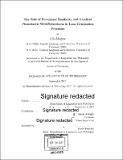The role of perceptual similarity and gradient phonotactic well-formedness in loan gemination processes/
Author(s)
Magyar, Lilla
DownloadFull printable version (12.05Mb)
Other Contributors
Massachusetts Institute of Technology. Department of Linguistics and Philosophy.
Advisor
Adam Albright.
Terms of use
Metadata
Show full item recordAbstract
Loan gemination is a cross-linguistically widespread phenomenon: short consonants preceded by short stressed vowels in the source language are borrowed as long in loanwords. It is generally considered to be an 'unnecessary' adaptation (Peperkamp, 2005), because it does not repair any illegal sequences in the native phonotactics of the borrowing languages. Hungarian is a particularly interesting case of a seemingly unnecessary adaptation: in the native phonology, both singletons and geminates can be found in word-final and intervocalic position (where loan gemination could potentially apply), therefore - on the face of it - there is nothing in the native phonotactics that would require gemination (Nddasdy, 1989). In this thesis, I present a detailed case study of Hungarian loan gemination and argue that this process is heavily influenced by native phonotactics (i.e. geminate markedness which is also reflected in the distribution of geminates in the native phonology), perceptual similarity effects (faithfulness to source vowel duration), and orthography. I propose a MaxEnt model with weighted constraints which incorporates these factors and predicts the probability of productive loan gemination.
Description
Thesis: Ph. D., Massachusetts Institute of Technology, Department of Linguistics and Philosophy, 2017. Cataloged from PDF version of thesis. Includes bibliographical references (pages 199-202).
Date issued
2017Department
Massachusetts Institute of Technology. Department of Linguistics and PhilosophyPublisher
Massachusetts Institute of Technology
Keywords
Linguistics and Philosophy.